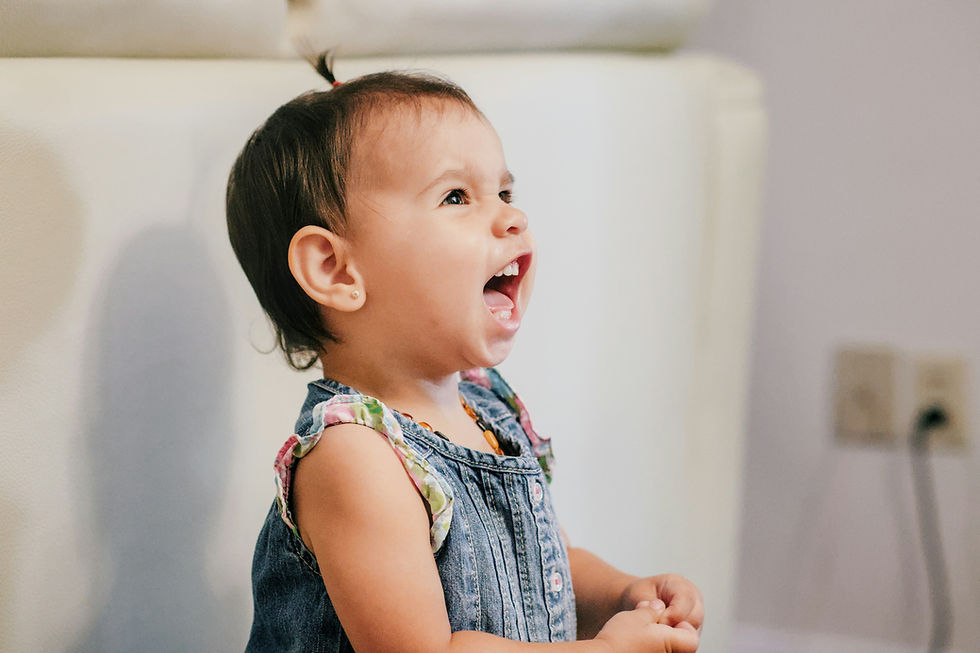Storms of Toddlerhood
- Sarah

- Sep 5
- 3 min read

If you’ve ever felt your heart race as your toddler drops to the floor screaming in the grocery store, you know that tantrums don’t just belong to toddlers—they happen to us, too. Their nervous system floods, ours responds in kind, and suddenly everyone’s on the edge.
The truth is: tantrums are not misbehavior. They are moments of overwhelm, for both the child and the parent, and opportunities to build resilience in the relationship.
🧠 Why Our Brains React the Way They Do
Even when we know on a rational level that our child is not a threat, our bodies don’t get the message right away. A toddler’s scream is piercing by design—evolution has shaped babies’ and toddlers’ cries to be impossible to ignore. The sound travels through the auditory system straight into the amygdala and brainstem, triggering a survival response before the “thinking brain” (the prefrontal cortex) even has a chance to interpret what’s happening (Siegel & Bryson, 2011).
This is why your heart races, your muscles tighten, and you may feel the urge to yell back, leave the room, or shut down. Polyvagal theory explains that the vagus nerve constantly scans for safety or danger (Porges, 2011). A toddler’s scream is coded as danger, even though it’s truly communication. Only later—once the initial wave passes—can your cortex step in and remind you, this is not life-or-death, this is my toddler asking for help in the only way they know how.
💃 The Dyadic Dance
Your toddler’s outburst is happening in relationship: they dysregulate, you co-regulate. Their brain learns calm not in isolation, but through your presence. Claudia Gold and Ed Tronick, in The Power of Discord (2020), emphasize that it’s not about preventing conflict, but how we repair and reconnect afterward. Each storm, each mismatch, is a chance to practice rupture and repair—laying down the neural pathways for resilience in both child and parent.
🤝 Keeping Steady Together
Parents are often told to “just take a deep breath,” but in the middle of a scream-fest, that advice can feel frustrating or impossible. Here are practical ways to stay steady while your toddler is in the storm:
Exhale longer than you inhale. You don’t need a perfect “deep breath”; a long exhale alone sends a safety signal to your nervous system. Think of the sound of opening a soda can, "ahhhhhhhhhh."
Stay near, even if silent. Presence is often more regulating than perfect words.
Name what’s happening. Simple reflections—“That was too much,” “You didn’t want that to happen”—help put feelings into language.
Offer comfort when they’re ready. Some toddlers want a hug; others need a little space before reconnecting.
Repair afterward. A gentle hug or a calm, “Wow, those were some big feelings. I’m here now” teaches resilience more than perfection ever could.
💛 Parental Mental Health
Parenting a toddler means being triggered into fight-flight-freeze sometimes dozens of times a day. That repeated activation can feel exhausting, overwhelming, and isolating. Your stress is valid—it’s a natural response to an intense, fast-moving relationship with a child whose nervous system is still under construction.
If you ever feel like the weight is too much to carry alone, support is available. At Baby and Me, we help parents navigate these challenges with compassion, practical strategies, and a focus on the parent-child relationship. You don’t have to do this on your own— reach out today to find support that fits your family.
🌱 What’s Coming Next
In the coming weeks, we’ll explore common toddler behaviors through a developmental and relational lens, including:
⚡ Power struggles & the need for autonomy
🤗 Clinginess & separation anxiety
👊 Aggression (hitting, biting, throwing)
😴 Sleep and transitions
Each post will offer gentle guidance and practical tools rooted in early relational health—and always, always with the knowledge that toddlers aren’t “misbehaving”… they’re becoming.
Internal Links
Learn more about the emotional life of toddlers
Start at the beginning with No, No, No: Welcome to Toddlerhood


Comments